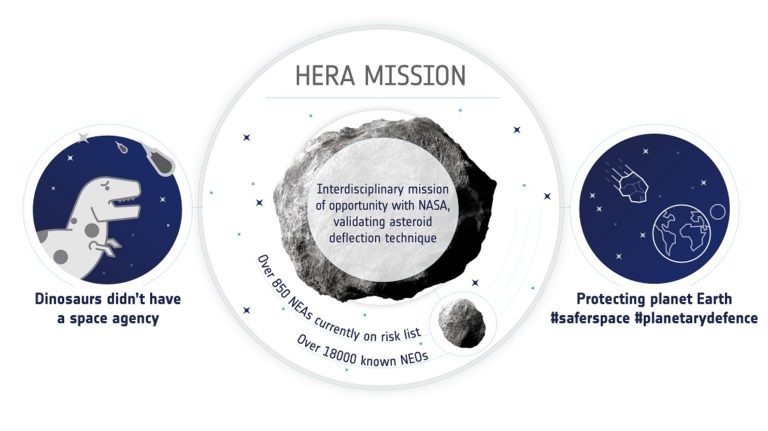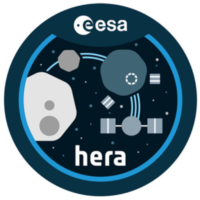Mission Summary
The Binary Asteroid Exploration Program Hera is ESA’s (European Space Agency) exploration program to rendezvous with the S-type asteroid Didymos and its satellite Dimorphos.
The AIDA (Asteroid Impact & Deflection Assessment) program is an international cooperative planetary defense program between ESA’s Hera and NASA’s DART.
DART launched on November 24, 2021, and collided with the satellite Dimorphos on September 26, 2022 UTC, at a speed of about 6 km/s. The impact was filmed from the previously separated child spacecraft (See topics; DART mission accomplished! https://hera.isas.jaxa.jp/wp-hera/en/3492/), and ground observations have confirmed that the orbital period around Didymos has been significantly shortened by approximately 32 minutes.
Hera launched on October 7, 2024, and will arrive in December 2026 to explore both Didymos and Dimorphos asteroids.
In particular, we will study in detail the changes in orbit and rotation caused by the impact of DART as well as the shape and size of its impact crater. In addition, the physical properties and materials of the target asteroid will be studied in detail over a period of six months.
Thermal imaging by Japan’s TIRI will make a significant contribution to both planetary science and planetary defense, especially in understanding the physical properties and formation processes of the Didymos binary asteroid system.

Figure 1|AIDA Plan
Mission Timeline
● NASA’s collider DART launched on November 24, 2021, and collided with Dimorphos (D~160m, P~11.9Hr), a satellite of asteroid Didymos (S-type, D~780m), on September 26, 2022 23:15 UTC (September 27, 2022 8:14 JST) at a speed of about 6 km/s.
● A CubeSat, LICIACube onboard DART and ground-based observations investigated phenomena at the time of impact and orbital changes after the impact, and then it was confirmed that the orbital period was shortened by approximately 32 minutes.
● ESA’s Hera spacecraft launched on October 7, 2024. A Mars swing-by was carried out on March 12, 2025, and observations of Mars and its moons Deimos and Phobos were conducted using three onboard cameras: the thermal infrared camera (TIRI), the optical camera (AFC), and the multicolor spectroscopic camera (HyperScout-H).
● Hera will then rendezvous with Didymos in December 2026, and conduct detailed observations of the impact crater formed by DART, detailed satellite orbit observations, and in-situ observations of both asteroids for about six months at altitudes from 30 km to less than 2 km.
●In addition, close observations will be made by two CubeSats, Juventas and Milani.
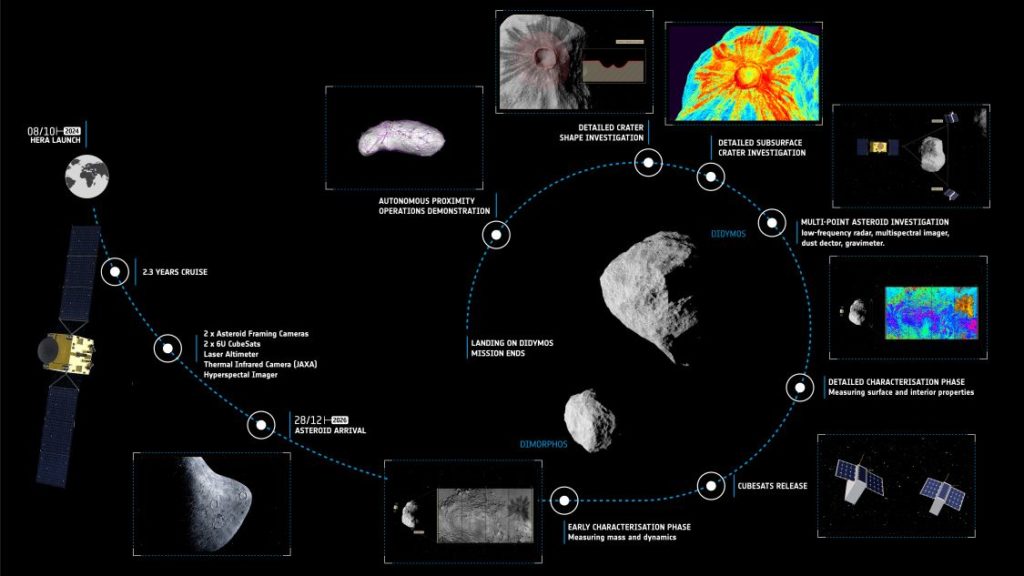
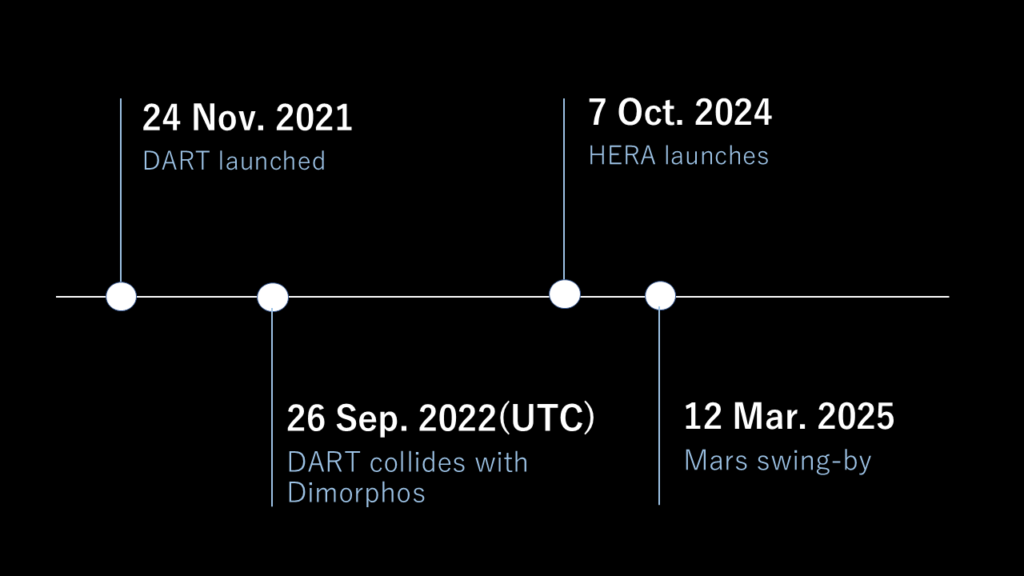
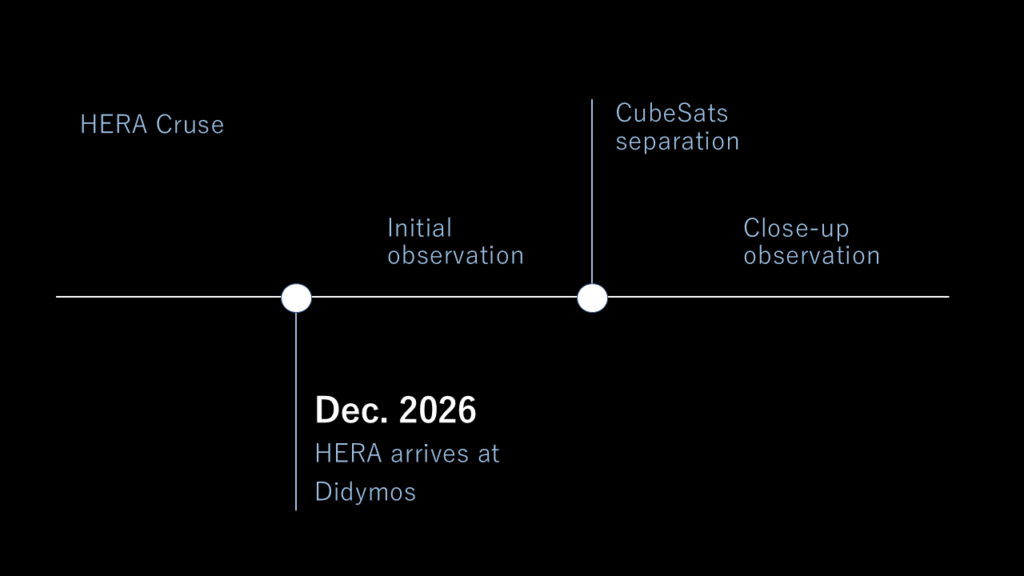
Why It's named Hera?
Hera, the name of the Greek goddess of marriage, was named by the international joint planetary defense project in collaboration with NASA’s DART.
Incidentally, in Greek mythology it is said that the Milky Way was created from Hera’s breast milk.
What is Planetary Defense?
More than 27,000 near-Earth asteroids with orbits that pass close to the Earth have been discovered so far. Near-Earth asteroids are potential threats to life and civilization on Earth because they may collide with the Earth in the near future. The Chicxulub Crater, 160 km in diameter in the Yucatan Peninsula, Mexico, is thought to be the remains of a small asteroid 10 km in diameter that collided with Earth 66 million years ago, and is considered the likely cause of the great extinction event at the end of the Cretaceous Period that wiped out many forms of life, including the dinosaurs. Moreover, it is the third largest meteorite impact crater ever discovered on Earth, meaning that asteroid impacts that caused major extinctions have occurred many times in Earth’s history.
Smaller asteroids are more numerous and those with a diameter of about 50 m, for example, collide with the Earth once every 100 to 1,000 years. In 1908, in Tunguska, Siberia, a meteorite with a diameter of 60 to 100 m caused a large explosion in the sky, and the blast destroyed a vast area of over 2,000 km square of taiga forest, almost the same area as Tokyo. On a somewhat smaller scale, a meteorite with an estimated diameter of 17 m that fell near Chelyabinsk, Russia, in 2013 caused a blast while passing through the atmosphere, resulting in a disaster that injured approximately 1,500 people and damaged approximately 4,500 homes. If it had hit a major city, the damage would have been immeasurable. In the event of an asteroid impact, which could cause enormous damage, disaster prevention measures are needed just as in the case of natural disasters such as earthquakes and tsunamis. When ground-based observations indicate that an asteroid is likely to collide with the earth within 100 years, the threat and possible damage can be prevented by deflecting the asteroid’s orbit and avoiding an impact with Earth. Planetary Defense is a space disaster prevention activity to prevent such threats and possible damage by using the knowledge of planetary science and space engineering technology.
As far as we know today, the only objects that have the potential to impact Earth within the next 100 years are small objects with diameters of less than 100 meters, so a collider with a size of a few meters can slightly alter the orbit of an asteroid by impacting it at high speed. Even with that small orbital change, if the impact with Earth can be changed to occur after a few tens of thousands of years, the immediate threat can be averted. However, since it is not easy to launch an object to reliably collide with a celestial body smaller than 100 m so a technological demonstration is required. The amount of orbital change caused by impact depends on the density and hardness of the asteroid, but the characteristics of small asteroids are not well understood.
